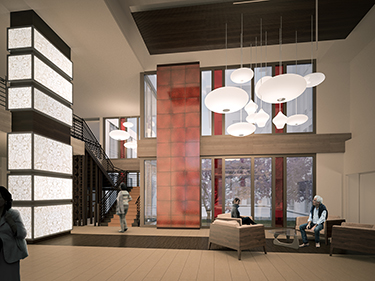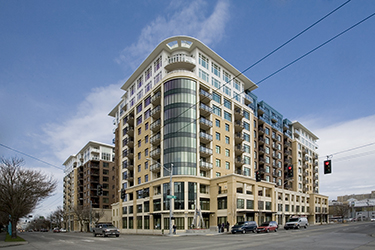|
Subscribe / Renew |
|
|
Contact Us |
|
| ► Subscribe to our Free Weekly Newsletter | |
| home | Welcome, sign in or click here to subscribe. | login |
Real Estate
| |
 |
July 28, 2016
Here's what baby boomers will do to senior housing industry
Ankrom Moisan Architects

Emery
|

Southerland
|
As 76 million U.S. baby boomers — more than half of whom are already 65 or older — enter retirement, the senior housing market is responding with a shift in product offerings to accommodate this highly diverse generation. Aside from demographics, the many wants and needs of boomers are driving senior housing providers to find unique, flexible solutions.
Through technology and access to information and resources, baby boomers are the first generation to truly participate in their own health care. They are aware of research regarding the negative health impacts that arise from isolation, and understand the importance of social wellness and community building as they age.
Whether designing new construction or repositioning existing campuses, common themes for attracting the boomers are always focused around choice.
Quality-of-life concerns
Modern medicine has managed to extend duration of life, but quality of life is determined by someone’s day-to-day infrastructure. Anxiety and depression, symptomatic of isolation, are some of the fastest-rising epidemics in our aging population.
Seniors’ use of technology to communicate with family is increasing, but with it may come an isolation resulting from the lack of face-to-face conversation. This is recognized within the industry, and trends are pushing toward social interaction as a critical component of a solid wellness program.
While it might seem counterintuitive, wine bars and demonstration kitchens are being added to the list of wellness amenities in today’s senior communities.
Another result of increased life expectancy is that senior housing is no longer filled with retirees. Many boomers are pursuing new careers, volunteer opportunities, positions in local governments and significant roles in community programs.
The common thread: most of these ventures will occur outside the walls wherever they live. Community connections, proximity to these opportunities, and access to transit or transportation resources are taking on a higher priority. Location is everything, and this retiring population has access to the geographic information they need to make informed choices about where they want to spend their time and resources.
Ankrom Moisan is working closely with clients to incorporate design and programming solutions that pair a strong focus on social interaction and community engagement with flexible options for care. As teams approach the design of new senior housing projects, they work to minimize the interruption of the social wellness developed over a resident’s time of residence in the facility, offering options of increased care with minimal disruption to the resident’s place in the community.
Narrower target groups
Because the boomer generation is so diverse, many senior housing developers are targeting specific groups to provide for a narrower set of wants and needs.
Addressing the desire to age in place, Ankrom Moisan is currently designing a community for seniors with strong, shared cultural experiences. This facility will allow residents to remain connected to one another, families, and their established neighborhood, while strengthening connections to their heritage.
Unique spaces — including a mahjong room, amphitheater and tea rooms — differentiate the facility and directly appeal to the resident base. The design also incorporates shared spaces with opportunities for day care, community gatherings, art events, and other uses that encourage residents to interact and participate within the larger community.
Aging in place
To further limit the amount of transition faced by seniors as their health care needs change, Ankrom Moisan is a proponent for flexible living units within senior communities.
This new business model utilizes portable licensing to allow for units to transition from independent living to assisted living. In order to provide residents with multiple options upon move-in, Ankrom Moisan designs unit sizes that are highly varied. Residents may start in a large unit with a full kitchen and bedroom, but can transition to a small studio unit to suit evolving needs and preferences.
While patient care remains a pertinent requirement for any successful senior housing project, flexibility and adaptability are crucial within today’s senior care models. Like their approach to lifestyle and amenities, boomers demand choice and the ability to influence the delivery of their care.
Increased acuity capabilities in assisted living and dedicated memory care households keep residents on site and in close proximity to the relationships they have established. Portable licensing and “acuity-flexing” from independent living to assisted living makes aging in place a reality.
Amenity spaces can also be designed to remain accessible to those with greater care needs, based on what is most comfortable for the resident. In a high-rise tower, this might include the main dining area staying open for residents with assisted-living licenses, but also providing a dining facility designed to accommodate their specific care needs.
Part of the community
Today’s senior communities are responding directly to the unique opportunities that arise from the site’s location, and may incorporate cooperative programming with art museums, institutions of higher learning and community groups.
Meanwhile, the public connections to these senior living communities are being strengthened with retail venues inside lobby spaces. Flexibility in lounge spaces and meeting rooms allows for a variety of functions, the content of which will be shaped by the population of active and involved residents. All of these changes work to promote impromptu intergenerational and multicultural interactions.
The community at large — those not typically associated with senior housing — is taking notice of the changing trends as well, and is seeking to further integrate with retiring boomers.
Arizona State University is at the forefront of this movement, opening a retirement community on their campus. Partnering with Pacific Retirement Services and Ankrom Moisan, the university is in the beginning stages of planning. Their vision for the community includes easy access to classes, the ASU library, and a Mayo Clinic within the complex.
Such intergenerational unification is mutually beneficial, aiding the improvement of residents’ social wellness by contributing to and interacting with a broader community.
The successful senior housing models of the future will find a way to provide opportunities for meaningful interactions and promote a sense of purpose not only for their residents, but also for the surrounding communities.
JP Emery, senior associate, joined Ankrom Moisan Architects in 2006. JP has more than 13 years of experience in architecture and design, specializing in senior communities and affordable housing. Jeremy Southerland brings 18 years of experience to Ankrom Moisan Architects as a project manager. Throughout his career he has been a market leader in senior living and health care design.
Other Stories:
- In-house ‘advocates’ help seniors thrive in low-income housing
- Senior housing that makes you feel like you’re in a boutique hotel
- Two senior communities, 1,370 miles apart, reflect their distinct settings
- Homebuilder focuses on wellness to attract active seniors




